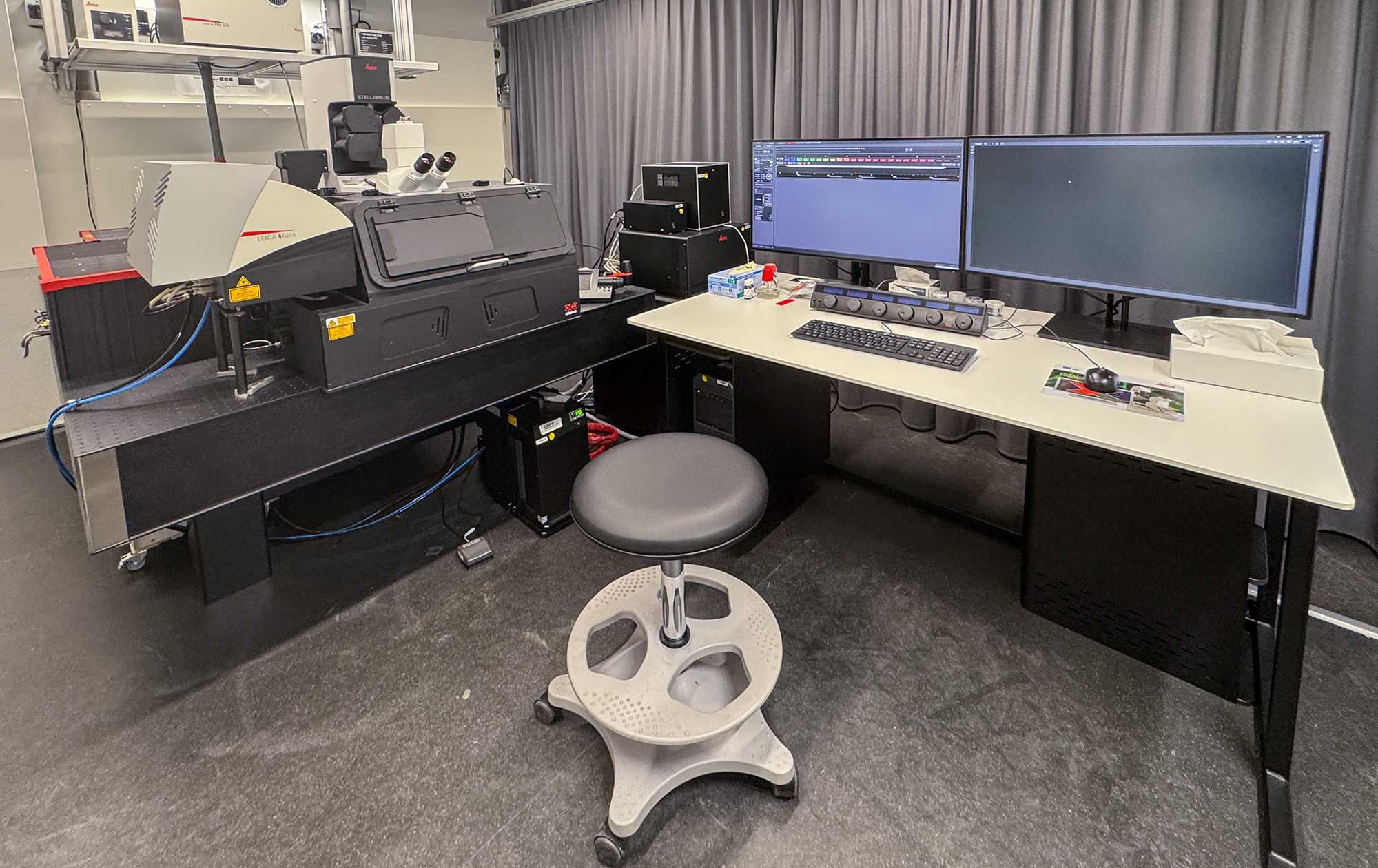Leica Stellaris Confocal MP
The Stellaris includes a White Light Laser (WLL) as excitation light source which allows a perfect match to peak excitation of fluorophores to ensure lowest laser exposure, optimal signal yield and emission separation of multi-labeled samples resulting in reduced toxicity and laser damage.
In combination with the Acousto Optical Beam Splitter (AOBS) and a highly sensitive, prism-based spectral detection with 5 internal Power HyD detectors which offer enhanced detection efficiency and photon counting, the Stellaris offers enhanced flexibility and performance and together with the LIGHTNING process it delivers superb image quality both at high speed and resolution.
The extended detection range of the detectors up to 850 nm plus the expanded excitation range of the White Light Laser in the visible from 440 nm up to 790 nm allow the application and separation of an extended range of spectrally overlapping fluorophores up to the NIR range.
In addition, including TauSense and FALCON, STELLARIS offers lifetime-based tools that provide additional information in qualitative or semi-quantitative manner using gate-based technology and mean average arrival time. It gives access to functional imaging, allows to remove undesired signal contribution and enables to separate spectrally overlapping fluorophores.
Technical details
Available Techniques:
- Confocal microscopy
- non-linear techniques (Mutliphoton excited Fluorescence, SHG, THG)
- Lifetime resolved microscopy (FLIM/Phasor analysis)
- Lifetime based dye separation (Tau contrast)
- Multiposition microscopy (mosaics and multiple positions)
- FRAP/FRET
- Job programming with Live Data mode
- Intra vital microscopy on animals
Stellaris Confocal
- STELLARIS 8 Tandemscanner (FOV and RS), 5 detectors (3x HyDs, HyD X, HyDR).
- WLL 440-790 nm with TauTools.
- Vis laser diodes: 405, 448, 488, 638 nm.
Multiphoton DIVE:
- DIVE Triple MP beamrouting
- Discovery NX MP laser (680-1300) plus fixed 1040 line
- Chamelion vision II (680-1080)
- AOM IR Laser attenuation
- Spectral 4 Tune 4 channel (4x HyD RLD)
- TauTools for MP imaging
- Pulse width 100 fs (at 900 nm). Pulse width 140 fs (fixed 1040 nm)
Software:
Leica LASX Stellaris version 4.8.0, available modules:
- Falcon FLIM (Phasor, Pattern fit, FRET, etc.)
- Navigator
- Lightning
- Live Data Mode
- physiology Wizards (FRET, FRAP)
- 3D visuation
Microscope:
Leica Upright DM6 CFS microscope stand with blue/red/green epifluorescence illumination for visual observation through eyepiece. Condensor (Air 0.55NA).
Microscope stage:
- Upright DM6 fixed xy-mot stage stand (Scientifica MMBP)
- Super-Z drive Minimum step size: 20 nm, adjustable in steps < 1.5 nm (full travel range) or < 0.5 nm (limited travel range), reproducibility: 40 nm, maximum travel range in z: 1500 µm
Objectives:
- 20x 0.75 NA Dry HC PL APO CS2
- 20x 1 NA WATER HCX APO L
- 25x 1 NA WATER HC IRAPO motCORR
- 25x 0.95 NA WATER HC FLUOTAR VISIR 0.17
- 40x 1.10 NA WATER HC PL IRAPO
- 40x 1.3 NA OIL HC PL APO CS2
- 63x 0.9 NA WATER HC APO LU-V-I-CS2
- 63x 1.4NA Oil HCX PL APO
Lasers:
- Vis and UV laser diodes: 405, 448, 488, 638 nm
- White light laser, pulsed: 440–790 nm
- Lasers MP:
- Coherent Dual Discovery, tunable from 680 to 1300 nm
- 1040 nm fixed laser line
- IR Laser Chameleon Vision II, freely tunable from 680 to 1080 nm
Detectors:
- 3 Power HyD S, 1 Power HyD X, 1 Power HyD R detectors, detection 410–850 nm
- non-descanned 4 RLD NDD HyD X, TLD NDD forward detection
